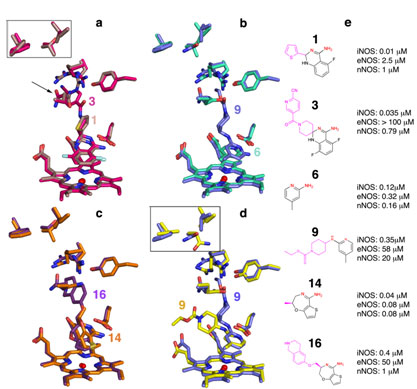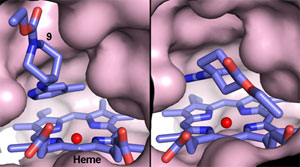
Nitric oxide (NO) has long been considered as a toxic pollutant. In the 90's,
Murad, Furchgott, Ignarro, and Moncada showed that it is also involved in
vascular relaxation in the human body1-4. NO is a small, diffusible, and
transient molecule produced in mammals from the amino acid arginine by three
nitric oxide synthase (NOS) enzymes. Low levels of NO produced by the
endothelial (eNOS) and neuronal (nNOS) enzymes are crucial for signaling,
including vasodilatation, thermoregulation, and neuroprotection. High levels of
NO are produced "on-demand" by the inducible (iNOS) enzyme, to help kill
tumors, bacteria, and viruses. Both underproduction and overproduction of NO
have been linked to various human pathologies. Impaired NO bioavailability from
eNOS and nNOS can lead to hypertension, impotence, or atherosclerosis, whereas
excess NO production by iNOS can cause inflammation, rheumatoid arthritis,
inflammatory bowel disease, immune-type diabetes, stroke, and cancer. The three
NOS isozymes are structurally similar and share identical active sites. Thus,
targeting iNOS without perturbing the activity of eNOS and nNOS is one of the
greatest challenges in the discovery of novel drugs to treat these diseases.
Most iNOS inhibitors have not proven successful as drugs, due to negative side
effects from high toxicity or poor selectivity.
|
 |
|
Figure 1.
NOS inhibitors. X-ray structures of 6 inhibitors bound to iNOS (a-c) and eNOS
(d) representative of three different pharmacophores used in this study. (a)
Binding mode of small (1) and large (3) quinazolines to iNOS. (b) Binding mode
of small (6) and large (9) aminopyridines to iNOS. (c) Binding mode of small
(14) and large (16) bicyclic thienooxazepines to iNOS. Binding of the large
inhibitors induces the cascade of conformational changes (arrow) and opening of
the new specificity pocket. (d) Binding mode of inhibitor 9 in iNOS (blue) and
eNOS (yellow) showing the absence of conformational changes in eNOS. Boxed
residues represent the isozyme-specific triad of distant residues that modulate
the opening of the pocket. (e) Structures and inhibitory potencies of 6 of the
inhibitors used in this study. The inhibitor core is shown in black and the
"tail" in magenta. IC50 values are shown for all three isozymes.
|
|
In this work directed by Elizabeth Getzoff at the Scripps Research Institute
(La Jolla, CA), Garcin et al. reveal a new method for the design of
selective inhibitors, i.e. those that specifically inhibit one enzyme (in this
case iNOS) without limiting the beneficial activities of related enzymes (eNOS
and nNOS). This new technique, termed the anchored plasticity approach,
should not only provide a general solution for the discovery of treatments for
diseases linked to NO overproduction, but also aid the development of drugs
against other enzyme families involved in medical conditions including HIV and
cancer.
The Getzoff team studied iNOS inhibitors provided by collaborator AstraZeneca.
These inhibitors had not yet proven adequate as drug treatments, but some
exhibited excellent selectivity for iNOS over eNOS (3000-fold), and reduced
pain and inflammation in rodent models of adjuvant-induced arthritis,
pancreatitis, neuropathy, and inflammation. Garcin et al. used x-ray
crystallography to examine at the atomic level the binding of these inhibitors
to iNOS and eNOS, and to determine what features specific to iNOS allowed
certain inhibitors to bind more effectively, and thus selectively.
|  |
|
Figure 2.
Binding mode for inhibitor 9 in iNOS and eNOS. In iNOS (left), inhibitor
binding induces conformational changes leading to the opening of a new binding
pocket allowing tight binding of the inhibitor tail. In eNOS (right), bulkier
residues far from the active site prevent the opening of the new pocket.
|
|
Using data collected at SSRL (and other synchrotrons), they determined
seventeen crystal structures of iNOS and eNOS bound to various inhibitors (Fig.
1). All these inhibitors mimic the binding of the arginine substrate in the
active site of both iNOS and eNOS. However, for some of these inhibitors, this
initial interaction promotes a cascade of subtle conformational changes
observed only in iNOS, and ultimately exposes a new binding pocket far away
from the active site. These surprising results were tested with more
inhibitors, and confirmed by mutagenesis. Effective binding in iNOS depends not
only on interactions within the conserved enzyme active site, but also on
interactions 20 Å away from the active site, much farther than was suspected.
Inhibitors only bind strongly to iNOS to block NO production when they contain
a "tail" large enough to bind in this new specificity pocket (Fig. 2;
inhibitors 3, 9, and 16). In eNOS, distant residues that are bulkier than those
in iNOS prevent the cascade of conformational changes and consequent opening of
the new binding pocket, thus resulting in poor inhibitor binding (Fig. 2).
Thus, for drug design, the plasticity of distant non-conserved residues can be
successfully used to modulate conformational changes of invariant active site
residues.
This anchored plasticity approach can be used for the design of selective
enzyme inhibitors by incorporating both a core for anchored binding in a
conserved active site and extended rigid substituents oriented to exploit
protein plasticity far away from the active site. This technique differs from
previous inhibitor design methods that focused on differences in residues
directly interacting with the inhibitor. These results, obtained with the help
of the SSRL beamlines, can be applied to future iNOS inhibitor design for the
treatment of inflammation, cancer, and other diseases, while reducing the risks
of disrupting the crucial activity of eNOS in maintaining blood pressure.
Primary Citation
Garcin E.D., Arvai, A.S., Rosenfeld R.J., Kroeger, M.D., Crane, B.R., Andersson
G., Andrews A., Hamley P.J., Mallinder P.R., Nicholls D.J., St-Gallay S.A.,
Tinker A.C., Gensmantel N.P., Mete A., Cheshire D.R., Connolly S., Stuehr D.J.,
Aberg A., Wallace A.V., Tainer J.A., Getzoff E.D. 'Anchored plasticity opens
doors for selective inhibitor design in nitric oxide synthase.' Nat. Chem.
Biol. 4 (2008), 700-707.
References
-
Katsuki, S., Arnold, W., Mittal, C. & Murad, F. Stimulation of
guanylate
cyclase by sodium nitroprusside, nitroglycerin and nitric oxide in various
tissue preparations and comparison to the effects of sodium azide and
hydroxylamine. J. Cyclic Nucleotide Res. 3, 23-35 (1977).
-
Ignarro, L.J.,
Buga, G.M., Wood, K.S., Byrns, R.E. & Chaudhuri, G. Endothelium-derived
relaxing factor produced and released from artery and vein is nitric oxide.
Proc. Natl. Acad. Sci. USA 84, 9265-9269 (1987).
-
Khan, M.T. & Furchgott,
R. Additional evidence that endothelium-derived relaxing factor is nitric
oxide, (Elsevier, Amsterdam, 1987).
-
Palmer, R.M.J., Ferrige, A.G. &
Moncada, S. Nitric oxide release accounts for the biological activity of
endothelium-derived relaxing factor. Nature 327, 524-526 (1987).
|
|
This work was supported through grants from the U.S. National Institutes of
Health and by the Skaggs Institute for Chemical Biology.
| PDF version | | Lay
Summary | |
Highlights Archive
|
SSRL is supported
by the Department of Energy, Office of Basic Energy Sciences. The SSRL
Structural Molecular Biology Program is supported by the Department of Energy,
Office of Biological and Environmental Research, and by the National Institutes
of Health, National Center for Research Resources, Biomedical Technology
Program, and the National Institute of General Medical Sciences.
|
|



